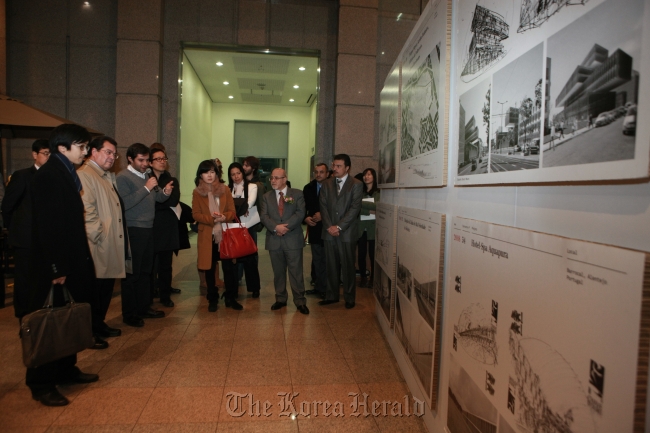Envoy brings exhibition on Portuguese architecture to Korea
By Korea HeraldPublished : Dec. 2, 2012 - 20:22

Portuguese Ambassador to Korea Antonio Quinteiro Nobre inaugurated a special architecture exhibition at Yonsei University on Monday that celebrates the winner of 2011’s “Nobel Prize in architecture” on Monday.
An extensive body of work by Portuguese architect Eduardo Souto de Moura, the winner of the Pritzker Prize in 2011 ― often called architecture world’s “Nobel Prize” ― is celebrated in “Eduardo Souto de Moura Competitions: 1979-2010” at Atrium Hall of Yonsei University’s Engineering Department through Dec. 7.
Souto de Moura is known for incorporating local history, context and landscape into his work.
He has designed everything from homes to shopping malls, but few were built outside of his hometown of Porto, and fewer still outside his country, Portugal and, before receiving architecture’s highest honor last year, he was not even known outside the architecture world.
Now his work can be seen in Korea for the first time.
Lord Peter Palumbo, chairman of the Pritzker jury, described his buildings as “have a unique ability to convey seemingly conflicting characteristics ― power and modesty, bravado and subtlety, bold public authority and a sense of intimacy ― at the same time” in statement on the group’s web site.
His best known works are in Portugal: The Estadio Municipal de Braga, a soccer stadium; the Burga Tower in hometown Porto; and the Paula Rego Museum in Cascais.
The stadium is often described as muscular, monumental and very much at home within its powerful landscape.
By Philip Iglauer (ephilip201l@heraldcorp.com)
An extensive body of work by Portuguese architect Eduardo Souto de Moura, the winner of the Pritzker Prize in 2011 ― often called architecture world’s “Nobel Prize” ― is celebrated in “Eduardo Souto de Moura Competitions: 1979-2010” at Atrium Hall of Yonsei University’s Engineering Department through Dec. 7.
Souto de Moura is known for incorporating local history, context and landscape into his work.
He has designed everything from homes to shopping malls, but few were built outside of his hometown of Porto, and fewer still outside his country, Portugal and, before receiving architecture’s highest honor last year, he was not even known outside the architecture world.
Now his work can be seen in Korea for the first time.
Lord Peter Palumbo, chairman of the Pritzker jury, described his buildings as “have a unique ability to convey seemingly conflicting characteristics ― power and modesty, bravado and subtlety, bold public authority and a sense of intimacy ― at the same time” in statement on the group’s web site.
His best known works are in Portugal: The Estadio Municipal de Braga, a soccer stadium; the Burga Tower in hometown Porto; and the Paula Rego Museum in Cascais.
The stadium is often described as muscular, monumental and very much at home within its powerful landscape.
By Philip Iglauer (ephilip201l@heraldcorp.com)
-
Articles by Korea Herald





![[Music in drama] Rekindle a love that slipped through your fingers](http://res.heraldm.com/phpwas/restmb_idxmake.php?idx=644&simg=/content/image/2024/05/01/20240501050484_0.jpg&u=20240501151646)




![[New faces of Assembly] Architect behind ‘audacious initiative’ believes in denuclearized North Korea](http://res.heraldm.com/phpwas/restmb_idxmake.php?idx=644&simg=/content/image/2024/05/01/20240501050627_0.jpg&u=20240502093000)








![[Today’s K-pop] Stray Kids go gold in US with ‘Maniac’](http://res.heraldm.com/phpwas/restmb_idxmake.php?idx=642&simg=/content/image/2024/05/02/20240502050771_0.jpg&u=)